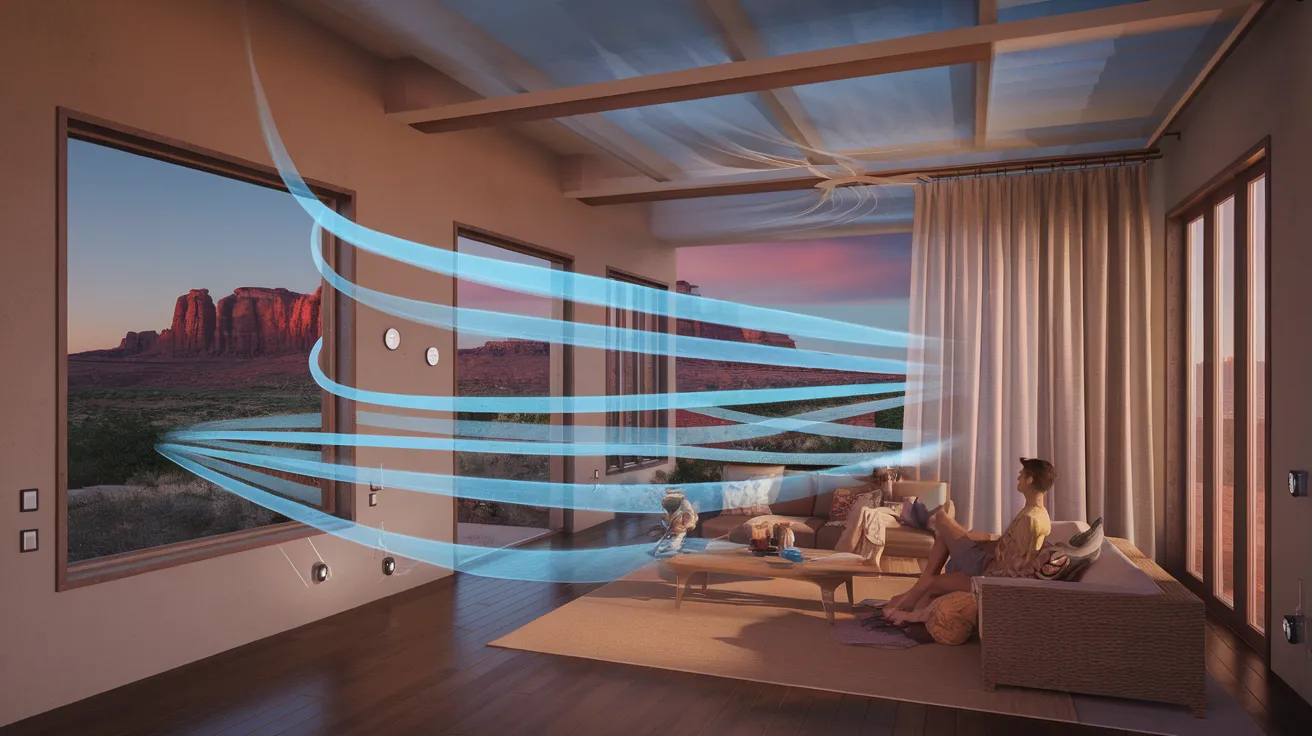Keeping cool in the hot Southern Utah climate can be budget-friendly while saving energy. Prioritize proper insulation, programmable thermostat use, and routine air conditioning upkeep. Utilize natural ventilation, add window protection, and evaluate the benefits of high-efficiency ductless units. Pay attention to the impact of thoughtful outdoor planning, like well-planned tree locations and cooling ground surfaces, which can reduce heat absorption. Want to discover the nitty-gritty of converting your living space into a summer oasis without running your AC constantly and increasing energy costs? Follow along!

Core Insights
Getting to Know the Principles of Power-Efficient Cooling
While you might think that maximizing the air conditioner is the sole solution to maintain a cool house during summer, understanding the basics of energy-efficient cooling offers a different view. It's not just about comfort, it's also about energy conservation. Keep in mind that cooling techniques like shading, ventilation, and insulation can significantly decrease your energy usage. By adding proper insulation, you're stopping cool air from escaping, thereby minimizing the need to constantly use your AC. Shading your windows, especially those exposed to sunlight, can decrease heat gain. And ventilation, whether passive or powered, helps promote airflow, ensuring a comfortable environment. A more energy-efficient home isn't merely budget-friendly, it's environmentally-friendly too.
Choosing the Perfect Air Conditioning Unit
Knowing how to cool efficiently is a solid basis. However, choosing the right air conditioning system is crucial to optimize these methods. The choice between central and ductless requires careful thought. Central air provides whole-house cooling, while ductless systems target individual zones. Both options have their benefits, but ductless units often save more energy if you don't use all rooms regularly. Check the energy ratings when deciding on a unit. Superior ratings show greater efficiency, but may cost more initially. It's about finding the right balance, but selecting a high-performance unit will save money long-term. Note that proper equipment helps control that Southern Utah heat effectively.
The Impact of Home Insulation in Cooling Your Living Space
Though it might not be obvious at first, effective insulation has a vital role in regulating indoor comfort during the warmest times of the year. Insulation materials operate by creating thermal resistance, decreasing the rate of heat transfer from your indoor space to the scorching outdoors. This means that the climate-controlled atmosphere produced by your air conditioning system is retained more effectively, reducing the strain on your AC unit and reducing costs on energy bills. It's essential to select insulation with a high R-value, which signifies greater thermal resistance. From spray foam to fiberglass, the appropriate insulation can make a world of difference in your home's seasonal temperature control and energy efficiency.
Harnessing the Power of Natural Ventilation
You can leverage natural ventilation to help keep your home comfortable and decrease your energy costs. By learning about how it works, you can get the most from the benefits of cross-ventilation during the day. Moreover, using a nighttime ventilation approach can offer significant cooling results when temperatures decrease.
Natural Ventilation Explained
While it may seem complicated, grasping natural ventilation can be straightforward. The focus is on optimizing the airflow in your home to maintain comfort while minimizing reliance on energy-intensive air conditioning. The key is knowing when to open your windows and doors to let the cool air in, and when to shut them to maintain cooler temperatures. You'll also want to understand multiple ventilation techniques that can enhance airflow, such as using fans in strategic locations and making channels for air to move freely. By harnessing the power of natural ventilation, you're not only keeping your home cooler, you're also contributing to a more sustainable future.
Understanding Cross-Ventilation Benefits
To properly leverage the effectiveness of natural ventilation, it's vital to maximize cross-ventilation benefits. This necessitates carefully positioned windows and implementing cross ventilation techniques. When fitting windows, target those that are positioned opposite each other. This forms a route for air to circulate through your home, thereby cooling it naturally.
Moreover, you can improve this process by opening adjacent windows. This promotes a cross breeze that can considerably decrease indoor temperatures. To make the most of the effectiveness, verify that the windows are clear from obstructions, both indoors and outdoors, such as plants or furniture. By monitoring these details, you're maximizing natural ventilation and lowering your dependence on power-hungry cooling systems.
Nighttime Air Management Strategy
Even though summer days might feel blazing hot, the nights typically bring an invigorating coolness that you can utilize to your advantage. Here's where an evening cooling strategy comes into play. By utilizing the advantage of passive cooling, you can accomplish effective nighttime cooling and enhanced air circulation.
Start by propping open windows and doors once the outside temperature falls below the inside temperature. This facilitates cool air to come inside and push the warm air out, establishing a natural air circulation. Then, as dawn approaches and the temperature starts increasing, close everything up to keep the cool air inside. Applying this basic but efficient strategy can create a significant difference in maintaining a cozy and energy-efficient home during the scorching Southern Utah summers.
The Critical Role of AC Maintenance
Many people don't know, but regular HVAC upkeep is essential in stopping system failures during the hottest times of the year. It not only enhances your AC's performance, but it's also key to extending the unit's service life. Let's explore what makes this crucial to your home's energy efficiency.
Managing System Overloading
When summer temperatures can force your AC system to its limits, regular maintenance can help prevent system overloads. Consider your AC similar to a car. You wouldn't commence a long road trip without checking the oil, would you? The same goes for your cooling system. Regular check-ups can maintain optimal performance, lower the risk of malfunctions, and contribute to energy savings.
Proactive measures involve replacing filters each month, cleaning the coils, and verifying sufficient refrigerant. Overlooking these important procedures can lead to system inefficiency, making your cooling system to operate inefficiently and consume additional energy. So, take care of your cooling system. Routine upkeep not only reduces excessive strain but further lengthens its lifespan.
Boosting AC Efficiency
To ensure your AC runs at maximum efficiency, routine upkeep must be a top priority. Failing to do this can result in lower effectiveness and increasing bills. Avoid this situation. AC optimization strategies include regularly maintaining filters, verifying your system runs at optimal levels.
Making improvements to your cooling system is valuable. Installing a programmable thermostat enables you to adjust temperature settings, minimizing power usage during vacant hours. You should also think about sealing your cooling ducts. Leaky ducts can waste up to 30% of your cooling system's output.
To maximize your AC's efficiency, it's essential to keep up with maintenance and consider system enhancement here options. You'll enjoy a more comfortable house and reduced utility expenses this summer.
Increasing Equipment Longevity
Beyond the immediate advantages of lower power usage and cost savings, routine AC maintenance also plays a pivotal role in extending the durability of your system. Consistent unit care extends further than addressing issues when they occur; it's about proactive care. By consistently maintaining and checking your AC system, you decrease component stress, enhance operation, and increase its durability. Think of it as an investment in lifespan extension. Keep in mind, a regularly maintained AC unit doesn't just perform better it has extended durability. So, don't overlook regular maintenance. It'll keep your system running smoothly, reduce your costs in the long run, and help you beat the Southern Utah heat effectively and efficiently.
Intelligent Thermostats: The Future of Energy Conservation
For those searching for an efficient energy-saving solution this summer, a smart thermostat may be the game changer you need. Being able to memorize your daily habits and regulate temperature as needed, it surpasses conventional thermostats. The advantages of a smart thermostat transcend simple convenience. By using one, you're making a conscious choice to boost energy conservation in your home, and this can lead to significant energy savings. You can also adjust from afar it through an app, delivering even more flexibility. Essentially, a smart thermostat offers comprehensive management of your home's energy use, keeping you comfortable in the Southern Utah heat without straining your budget.
Smart Landscaping Strategies for Enhanced Cooling and Energy Savings
While a smart thermostat remains an impressive way of controlling energy use in your home, another effective method lies in smart landscaping. Strategically placing shade trees along the south and west sides of your home can decrease your air conditioning needs substantially. These natural shade providers serve as natural shields against the sun's heat, promoting outdoor cooling.
Try adding xeriscaping plants to your garden. These low-water plants require less water, helping to preserve this important resource. Furthermore, their ability to survive in warm conditions promotes a more temperate environment.
In conclusion, stay away from dark and absorbent materials for patios or walkways. Opt for reflective surfaces as an alternative. They bounce back the sun's rays, additionally lowering heat around your home and boosting your energy efficiency.
Popular Questions
Understanding How Humidity Influences Efficient Air Conditioning Across Southern Utah?
Humidity has a significant impact on the energy efficiency of your cooling system. Your system uses more energy when dealing with humid air, which means more power is needed. For this reason, adding a dehumidifier can help reduce your AC's workload and help you save on energy expenses.
What Are Some Energy-Efficient Alternatives to Air Conditioning?
You can consider evaporative coolers and ceiling fans as power-saving solutions to conventional air conditioning. These options are efficient, use minimal energy, and reduce your energy footprint. This is a sensible, economical option for keeping your Southern Utah home cool.
How Effective Is Solar Power for Cooling Applications
Indeed, you are able to use solar power for efficient cooling. Solar cooling systems leverage solar panel capabilities to energize your cooling demands, making it a sustainable, budget-friendly option to traditional air conditioning.
How Do Evening Temperatures Impact Energy Efficiency?
As outdoor temperatures decrease at night, it's a perfect opportunity to improve power consumption. Open your windows to welcome the cool air, allowing you to minimize reliance on air conditioning. Remember that strategically controlling overnight temperature drops is a smart approach to temperature changes.
Tax Benefits Available When Installing Energy-Efficient Cooling Systems
You're eligible for tax incentives when setting up eco-friendly cooling solutions. Explore federal and local programs for rebates on installation. It's an effective method to lower your investment while decreasing your ecological footprint and cooling costs during summer.
Conclusion
You're all set to beat the Southern Utah heat this summer! Remember, an energy-efficient cooling system is easier to achieve than finding a snowball in the desert. With the right AC, quality insulation, proper ventilation, regular maintenance, a modern thermostat, and strategic landscaping, you can enjoy a cool, comfortable home without breaking the bank. You're saving energy while, you're contributing to a meaningful step towards sustainable living.
 Amanda Bearse Then & Now!
Amanda Bearse Then & Now! Keshia Knight Pulliam Then & Now!
Keshia Knight Pulliam Then & Now! Barbi Benton Then & Now!
Barbi Benton Then & Now! Barbara Eden Then & Now!
Barbara Eden Then & Now! Bill Murray Then & Now!
Bill Murray Then & Now!